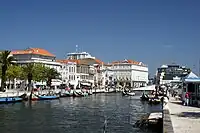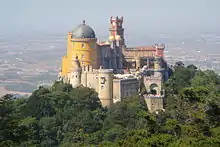.jpg.webp)

%252C_by_Klugschnacker_in_Wikipedia_(86).JPG.webp)

.jpg.webp)
.jpg.webp)
_(cropped).jpg.webp)



Tourism in Portugal serves millions of international and domestic tourists. Tourists visit to see cities, historic landmarks, enjoy beaches, or religious sites. As of 2019, Portugal had 27 million visitors.[1][2] The most popular destinations were Lisbon, Porto, the Algarve, the Portuguese Riviera, Madeira, Sintra, Óbidos and Fátima. The most popular with internationals were Lisbon, the Algarve and Northern Portugal. National tourists prefer Northern Portugal, followed by Central Portugal and the Algarve.[1]
Statistics
In 2006, the country was visited by 7 million tourists, three million of which came from Spain.[3] By 2018, the country was visited by 12.8 million international tourists.[4]
In 2016, and compared to 2015, most tourists staying in hotels were attracted to Lisbon (6.3 million, up from 5.8), Porto and Northern Portugal (4.4 million, up from 3.9), the Algarve (4.2 million, up from 3.8), Central Portugal (3.2 million, up from 2.9 million), Madeira (1.5 million, up from 1.3), Alentejo (1.2 million, up from 1.1), and the Azores (0.5 million, up from 0.4). The Algarve and Lisbon lead in overnight stays.[5] In 2016, overnight stays grew significantly in other regions: the Azores (+21.1%), Northern Portugal (+14.4%), Alentejo (+12%), Central Portugal (+11.8%), and Madeira (+10.9%).[6][7]
The following table presents the nationality of the largest demographic of tourists from 2017 to 2019:[1]
| Rank | Country | 2017 | 2018 | 2019 |
|---|---|---|---|---|
| 1 | 1,970,850 | 2,069,645 | 2,285,829 | |
| 2 | 2,099,008 | 2,042,867 | 2,145,902 | |
| 3 | 1,600,199 | 1,641,912 | 1,623,207 | |
| 4 | 1,565,904 | 1,602,066 | 1,541,398 | |
| 5 | 971,453 | 1,103,718 | 1,281,675 | |
| 6 | 790,141 | 981,822 | 1,202,247 | |
| 7 | 650,325 | 665,930 | 722,115 | |
| 8 | 617,124 | 610,161 | 598,375 | |
| 9 | 345,724 | 357,542 | 413,733 | |
| 10 | - | 324,258 | 385,307 | |
| 11 | - | 346,428 | 380,896 | |
| 12 | 312,029 | 327,264 | 325,799 | |
| 13 | - | 303,013 | 304,867 | |
| 14 | - | 285,362 | 277,616 | |
| 15 | - | 190,183 | 183,717 | |
| 16 | - | 142,573 | 144,490 | |
| 17 | Other foreign | 3,666,674 | 2,313,413 | 2,592,941 |
| Total international visitors | 14,589,431 | 15,308,157 | 16,410,114 | |
In 2016, accounting international tourists, the most popular regions were Lisbon (4.4 million), Algarve (3 million), Northern Portugal (2.1 million), Central Portugal (1.2), Madeira (1.2), Alentejo 370,000 and the Azores. For national tourists the most popular regions were Northern Portugal (2.3), Central Portugal (2.0), Lisbon (1.9), the Algarve (1.2), Alentejo (0.8), Madeira (0.29), and the Azores (0.27).[7]
The following table presents the nationality of the largest demographic of tourists by region in 2019:[1]
| Region | International Tourist guests | TOP 5 nationalities | National tourists |
|---|---|---|---|
| Lisbon | 5,986,638 | 1st | 2,230,043 |
| Algarve | 3,592,441 | 1st | 1,471,626 |
| Northern Portugal | 3,191,197 | 1st | 2,771,829 |
| Central Portugal | 1,636,776 | 1st | 2,481,880 |
| Madeira | 1,159,739 | 1st | 322,501 |
| Alentejo | 550,571 | 1st | 1,065,487 |
| The Azores | 382,752 | 1st | 388,936 |
Lisbon is, with Barcelona, one of the European cities leading in overnight stays.[8] The urban areas of Porto and Northern Portugal, north of Douro River surpassed Madeira, in 2010, and the Algarve, in 2015, and became the second most visited destination in Portugal. In 2015, most tourists were Europeans, but also from the Americas and Asia. Sleeping in the country's hotels, the most numerous are the British, Spanish, French, Germans, Brazilians, the Dutch, Americans, Italians, and the Japanese, which not only want the sun and the beach, but mostly cultural ones, city breaks, gastronomy, nautical tourism, or business traveling.
Portugal won 14 "Oscars" of the tourism. The national tourism had 77 nominations and won a total of 14 awards in more than 10 European categories, surpassing Spain or Italy, at the gala of the World Travel Awards 2015, whose ceremony took place in Sardinia, Italy. CNN compared Lisbon and Porto head-to-head in order to find who has the best food, culture, old cafés and boutiques, nightlife, and the best beaches.[9]
Travel guide giants Lonely Planet have designated Portugal as one of the top 3 countries to visit in 2018.[10]
Tourism regions
Tourist hotspots in Portugal are Lisbon, Porto, the Algarve, Madeira, Sintra, Óbidos, Fátima, Coimbra and Azores, but the Portuguese government is currently developing new destinations: the Douro Valley, Porto Santo Island, and Alentejo.
Portugal has several other tourism regions such as Douro Sul, Templários, Dão-Lafões, Costa do Sol, Costa Azul, Planície Dourada, etc. Most of them are unknown to tourists and locals alike. As of 2007, these are being reorganized.
All these regions are grouped in tourism reference areas, which are widely known because these are the traditional regions:
- Costa Verde in Norte Region — The Portuguese green coast comprises all the northern coast of Portugal from the estuary of the Minho River to the city of Porto.
- Costa de Prata in Centro Region — The Portuguese silver coast comprises from Porto to Lisbon. Fátima, Nazaré and Óbidos are 3 very important places.
- Portuguese Riviera (Sintra, Cascais and Estoril)
- Comporta — The northwestern coast of the Alentejo
- Caparica Coast — The coast south of Lisbon, across the Tagus river
- Montanhas — Mountainous and interior regions of northern and central Portugal, namely Serra da Estrela and Trás-os-Montes.
- Planícies — The Portuguese plane region of Alentejo in the south.
- Algarve — The southern coast of Portugal including the Golden Triangle.
- Madeira — The Madeira islands.
- Açores — The Azores islands.
Tourist regions
The main tourist regions can be broken-down into:
- the Greater Lisbon,
- the Greater Porto,
- the Algarve,
- the Alentejo,
- Central Portugal,
- Northern Portugal and
- the Portuguese Islands: Madeira and Azores.
Other tourist regions include Douro Sul, Templários, Dão-Lafões, Costa do Sol, Costa Azul, Planície Dourada, that are unknown to many tourists or visitors.
Most of these regions are grouped in tourism reference areas, which continue to be in a state of reorganization and evolution, some based on the traditional regions of Portugal: the Costa Verde (Green Coast); Costa da Prata (Silver Coast); Costa de Lisboa (Lisbon Coast); Montanhas (Mountains); Planícies (Plains); Algarve; and the islands of the archipelagos of Madeira and the Azores.
The Rooster of Barcelos is bought by many tourists as a souvenir. The legend of the Rooster of Barcelos tells the story of a dead rooster's miraculous intervention in proving the innocence of a man who had been falsely accused and sentenced to death. The story is associated with the 17th-century calvary that is part of the collection of the Archeological Museum located in Paço dos Condes, a gothic-style palace in Barcelos, a city in the Braga District of northwest Portugal.
The following table presents the number of visitors in each of the protected areas of Portugal, according to ICNF:[11]
| Protected Area | 2018 | 2019 | 2020 |
|---|---|---|---|
| Alvão | 25,368 | 58,630 | 9,303 |
| Arrábida | 30,435 | 28,795 | 2,668 |
| Arriba Fóssil da Costa da Caparica | 1,498 | 2,267 | 645 |
| Berlengas | 40,505 | 44,078 | 540 |
| Douro International | 28,743 | 60,570 | 0 |
| Dunas de São Jacinto | 6,348 | 5,400 | 3,219 |
| Estuário do Sado | 85,543 | 82,242 | 54,643 |
| Estuário do Tejo | 1,713 | 1,853 | 312 |
| Lagoas de Santo André e de Sancha | 12,857 | 8,942 | 2,245 |
| Litoral Norte | 4,582 | 6,723 | 5,752 |
| Madeira | 6,180 | 5,894 | 5,458 |
| Paul do Boquilobo | 2,319 | 1,956 | 1,305 |
| Peneda-Gerês | 112,227 | 103,593 | 39,485 |
| Paul de Arzila | 1,236 | 860 | 841 |
| Ria Formosa | 46,662 | 60,061 | 17,202 |
| Serra da Estrela | 3,079 | 18,429 | 4,202 |
| Sapal de Castro Marim e Vila Real de Santo António | 7,642 | 7,999 | 1,375 |
| Serra da Malcata | 4,097 | 3,951 | 649 |
| Serra de São Mamede | 4,556 | 9,934 | 2,620 |
| Serra do Açor | 6,124 | 5,284 | 3,429 |
| Serras de Aire e Candeeiros | 43,435 | 44,326 | 15,691 |
| Sintra-Cascais | 58,127 | 52,774 | 12,912 |
| Sudoeste Alentejano e Costa Vicentina | 15,950 | 18,027 | 3,593 |
| Tejo Internacional | * | 38 | * |
| Vale do Guadiana | 332 | 1,306 | 32 |
UNESCO World Heritage sites
See also
References
- 1 2 3 4 "Data and Resources". travelbi.turismodeportugal.pt. Retrieved 30 January 2021.
- ↑ "Lisbon, a city that moves and grows". The Business Report. Retrieved 24 January 2019.
- ↑ Três milhões de espanhóis visitaram Portugal em 2006. January 31, 2007. Público.
- ↑ https://www.portugalresident.com/2019/02/14/portugal-celebrates-new-tourism-record-21-million-tourists-in-2018/
- ↑ Estatísticas do Turismo - 2015 - INE
- ↑ Alojamento turístico acelera crescimento - 2016 - INE
- 1 2 Estatísticas do Turismo - 2016 - INE
- ↑ DN Online: Cidades atraem mais turistas do que os destinos sol e mar Archived 2007-02-18 at the Wayback Machine
- ↑ Paul Ames, CNN (27 July 2017). "Porto vs. Lisbon: 8 reasons Porto is cooler".
{{cite web}}:|author=has generic name (help) - ↑ "Lonely Planet Best in Travel 2018: Top Countries".
- ↑ "Número de visitantes que contactaram as áreas protegidas". ICNF. Retrieved 30 May 2021.
External links
- Portugal Official Tourism Website
- Algarve Official Tourism Website
- Center of Portugal
- Portugal Travel Guide
 Media related to Tourism in Portugal at Wikimedia Commons
Media related to Tourism in Portugal at Wikimedia Commons
.jpg.webp)


